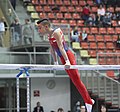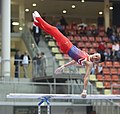Sergey Diomidov
 Sergey Diomidov in 1966 | ||||||||||||||||||||||||||||||||||||||||||||
| Personal information | ||||||||||||||||||||||||||||||||||||||||||||
|---|---|---|---|---|---|---|---|---|---|---|---|---|---|---|---|---|---|---|---|---|---|---|---|---|---|---|---|---|---|---|---|---|---|---|---|---|---|---|---|---|---|---|---|---|
| Born | 9 July 1943 Turtkul, Uzbekistan | |||||||||||||||||||||||||||||||||||||||||||
| Height | 1.72 m (5 ft 8 in) | |||||||||||||||||||||||||||||||||||||||||||
| Weight | 72 kg (159 lb) | |||||||||||||||||||||||||||||||||||||||||||
| Sport | ||||||||||||||||||||||||||||||||||||||||||||
| Sport | Artistic gymnastics | |||||||||||||||||||||||||||||||||||||||||||
| Club | VS Toshkent | |||||||||||||||||||||||||||||||||||||||||||
Medal record
| ||||||||||||||||||||||||||||||||||||||||||||
Sergey Viktorovich Diomidov (Russian: Сергей Викторович Диомидов; born 9 July 1943) is a Soviet former gymnast who competed in the 1964 Summer Olympics and in the 1968 Summer Olympics. He won team silver medals at both Games and a bronze on the vault in 1968.[1][2]
He invented a skill on parallel bars.[3]
Biography[]
Between 1961 and 1967, Diomidov trained at the Amy Forces Club in Tashkent, Uzbekistan. In 1968, he moved to Moscow where he was coached by Konstantin Karakashyants at the CSKA club. He retired in 1972[4] and holds a rank of lieutenant colonel.[5]
Gymnastics competition history[]
Apart from his Olympic team medals, he was part of two silver medal teams at world championships, in 1966 and 1970; at the 1966 championships, he also won the gold on parallel bars.[6] In addition, he earned several medals at USSR and European championships.[4]
Parallel bars skill[]
The "Diamidov" is a move on parallel bars. It consists of a swing down from handstand, through support, then releasing one hand and twisting the body a full turn, before regrasping in handstand.[7][8] It is similar to the , with the difference being that the Stutz involves a half turn only, but release of both hands.[9]
References[]
- ^ "Sergey Diomidov". sports-reference. Archived from the original on 2020-04-17.
- ^ Van Deusen, Amy. "Men's vault (Olympic Gymnastics Medalists)". Gymnastics. About.com. Retrieved 17 March 2013.
- ^ "Спортсмены Узбекистана" [Sportsmen from Uzbekistan]. National Olympic Committee of Uzbekistan. Archived from the original on February 25, 2012. Retrieved 17 March 2013.
- ^ a b Sergei Diomidov (USSR). gymn-forum.net
- ^ "Диамидов Сергей Викторович" [Sergei Viktorovich Diamidov]. The Contemporary Museum of Sports. Retrieved 17 March 2013.
- ^ Van Deusen, Amy. "World Champions in Men's Gymnastics (Rings, Vault, Parallel Bars, and High Bar)". Gymnastics. About.com. Retrieved 17 March 2013.
- ^ Gutman, Dan (1998) Gymnastics. Penguin Press, ISBN 1101160659.
- ^ Gymnastics: Glossary. 2008.nbcolympics.com
- ^ Sands, Bill and Conklin, Mike (1984) Everybody's Gymnastics Book, Scribner, ISBN 068418091X, p. 139: "The Diamidov begins from a stutz, which is a swing half-turn instead of a full turn. The stutz involves some flight but does not require the gymnast to swing quite as high as in the Diamidov."
External links[]
| Wikimedia Commons has media related to Sergey Diomidov. |
- 1943 births
- Living people
- Uzbekistani male artistic gymnasts
- Soviet male artistic gymnasts
- Olympic gymnasts of the Soviet Union
- Gymnasts at the 1964 Summer Olympics
- Gymnasts at the 1968 Summer Olympics
- Olympic silver medalists for the Soviet Union
- Olympic bronze medalists for the Soviet Union
- Olympic medalists in gymnastics
- Medalists at the 1968 Summer Olympics
- Medalists at the 1964 Summer Olympics
- Medalists at the World Artistic Gymnastics Championships
- Originators of elements in artistic gymnastics






